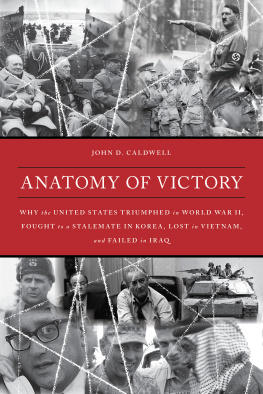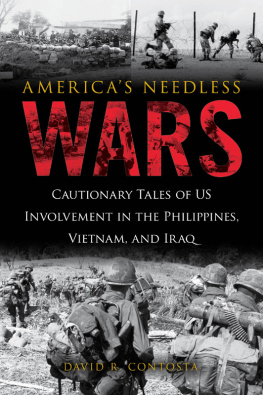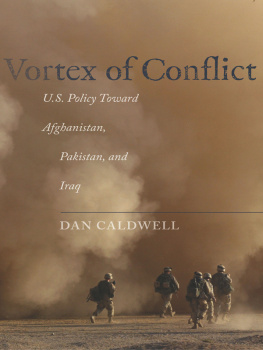Anatomy of Victory
Anatomy of Victory
Why the United States Triumphed in World War II, Fought to a Stalemate in Korea, Lost in Vietnam, and Failed in Iraq
John D. Caldwell
ROWMAN & LITTLEFIELD
Lanham Boulder New York London
Published by Rowman & Littlefield
An imprint of The Rowman & Littlefield Publishing Group, Inc.
4501 Forbes Boulevard, Suite 200, Lanham, Maryland 20706
www.rowman.com
Unit A, Whitacre Mews, 26-34 Stannary Street, London SE11 4AB, United Kingdom
Distributed by NATIONAL BOOK NETWORK
Copyright 2019 by John D. Caldwell
All rights reserved . No part of this book may be reproduced in any form or by any electronic or mechanical means, including information storage and retrieval systems, without written permission from the publisher, except by a reviewer who may quote passages in a review.
British Library Cataloguing in Publication Information Available
Library of Congress Cataloging-in-Publication Data
Names: Caldwell, John Dean, 1940 author.
Title: Anatomy of victory : why the United States triumphed in World War II, fought to a stalemate in Korea, lost in Vietnam, and failed in Iraq / John D. Caldwell.
Description: Lanham : Rowman & Littlefield, [2019] | Includes bibliographical references and index.
Identifiers: LCCN 2018017886 (print) | LCCN 2018034665 (ebook) | ISBN 9781538114780 (ebook) | ISBN 9781538114773 | ISBN 9781538114773 (cloth : alk. paper)
Subjects: LCSH: United StatesHistory, Military20th century. | United StatesHistory, Military21st century.
Classification: LCC E745 (ebook) | LCC E745 .C28 2019 (print) | DDC 355.00973/0904dc23
LC record available at https://lccn.loc.gov/2018017886
 The paper used in this publication meets the minimum requirements of American National Standard for Information SciencesPermanence of Paper for Printed Library Materials, ANSI/NISO Z39.48-1992.
The paper used in this publication meets the minimum requirements of American National Standard for Information SciencesPermanence of Paper for Printed Library Materials, ANSI/NISO Z39.48-1992.
Printed in the United States of America
To the Armed Forces of the United States
Preface
W riting about the armed forces of the United States and their allies is a humbling experience. Studying the accounts of expeditionary operations during World War II and the Korean, Vietnam, and Iraqi Wars reveals extraordinary levels of duty, courage, patriotism, and sacrifice. These four major conflicts into which eleven presidents since 1941 committed our forces to fight convinces me that I was lucky to have been born an American. There is no other country in the world capable of fielding such forces to bear the international burdens that Americans in December 1941 found themselves assuming globally. Whether one regards American participation in the postwar conflicts as wise or unwise, our forces did not make that choice. Presidents did. Our fighting forces carry out military direction from duly constituted national executive authority regardless of whether Congress goes through the constitutional formality of declaring war.
The original impetus for this book began almost fifty years ago in my salad days as I was beginning my first real job in Saigon in the middle of a war. In March 1968, I met Jeffrey Race for the first time. A US Army first lieutenant, he had already served two combat tours in Vietnam and returned to Saigon as a civilian to begin research for a book about the war. Within minutes of my first encounter with Jeffrey, he told me, John, we are going to lose the Vietnam War. I was shocked. The Tet Offensive was barely a month old. It seemed to me that we were winning, or at least holding our own. What astonished me even more was the scale of the American way of warthe sheer size of our military commitment to the theater and logistically how lavishly it was being supplied. American manpower was at its peak in 1968: more than a half million mentwelve divisionssupported by a large naval fleet offshore in the South China Sea and 1,700 combat aircraft dedicated to the theater. Large combat bases seemed to be everywhere, especially in the Saigon area. How could we lose? Jeffrey put it very simply: our enemies have a theory of victory and we dont. That compelling phrase has resonated with me over half a lifetime.
After I retired from a four-decade career in defense think tanks and aerospace companies, I thought I might be ready to address Jeffreys assertion about what has happened over the course of our lifetimes: theories of victory that neither succeeded the way World War II did nor produced outcomes that satisfied the American people. My work experience has been a learning one, about war fighting, leadership, technology, weapons systems, and the people who design, build, and use them.
One thing that made a powerful early impression on me was meeting combat soldiers and military advisors in Vietnam. The officers, NCOs, and enlisted men and women I encountered, officially and unofficially, over a lifetime in the business of the military-industrial complex uniformly impressed me as implacably honest, well-informed, and, in many cases, extraordinarily well-educated people, who took their military responsibilities and duties very seriously, often in life-threatening circumstances. I learned much from them, as well as from my aerospace colleagues, many of whom are military veterans themselves. I am particularly grateful to my colleagues with whom I worked starting in 1982 at TRWs Defense Systems Group as an advanced systems manager and, later, in 1989, in TRW Proposal Operations (Northrop Grumman Aerospace Systems after NG acquired TRW in 2002). Proposal Ops was an organization founded and led by the late Sam Petralia. Sams able successorsMr. Stephen C. Hart, Dr. Robert Goldstein, and Mr. Greg Davidsoncontinued his legacy that excellence wins. From all of them, I learned how rigorous, disciplined thought processes make writing easier. Proposals, of course, are about winning and losing. My colleagues may recognize that I still use some of the vernacular, particularly the very useful analytical distinction between discriminators and differentiators and the value of Dr. Goldsteins canon that assertion of a feature without hard evidence of a proof (preferably with quantitative data) is meaningless. I long ago became a student of geopolitics and war and read widely.
The idea of winning and losing was at the center of how I began researching and writing this work. World War II has long been the historical paradigm for winningbecause there has never been any doubt in any informed mind about who won. I imagine that is one of the reasons why the reading publics appetite for any book about World War II makes for good sales in the marketplace. Another reason is demographic: virtually everyone in the 1940s and in the generations that followed knew of a family member or friend who served in the armed forces of the United States, so there is abiding curiosity about the war.
I thought that if I began with World War II as a benchmark, some lessons might emerge about how to think about the postwar conflicts. That indeed turned out to be the case. There is much to be learned from what the Allies did in World War II that could have informed how the United States fought in Korea, Vietnam, and Iraq.
That is the reason I have dedicated this work to the millions of our countrymen in the US Armed Forces who were sent to fight in these conflictsespecially to those who never came home.
I have been profoundly impressed with Professor Eliot Cohens Supreme Command and the five critical functions of leadership he identifies virtually on the first page of his seminal book. Whether friend or foe, combatant political and military leaders have to set direction, pick winning generals, plan and execute effectively, accommodate critical domestic and international constituencies, and communicate convincingly to wartime publics. The substantive definition and performance of these functions constitutes a strategic architecture. How well combatant statesmen and generals perform these functions determines conflict outcomes.
Next page
















 The paper used in this publication meets the minimum requirements of American National Standard for Information SciencesPermanence of Paper for Printed Library Materials, ANSI/NISO Z39.48-1992.
The paper used in this publication meets the minimum requirements of American National Standard for Information SciencesPermanence of Paper for Printed Library Materials, ANSI/NISO Z39.48-1992.